
(Rafinesque) Rafinesque, Flora Medica (or Manual of the Medical Botany of the United States of North America) 2: 247, 1830
Neotype; Herbarium; Herbarium; Herbarium; Herbarium; Herbarium; Herbarium; Herbarium; Herbarium; Herbarium; Herbarium (as O. calcicola); Herbarium (as Cactus humifusus); Herbarium (as Cactus opuntia) Drawing (Curtis’s Botanical Magazine, vol. 50: pl 2393, 1823 [as Cactus opuntia]); Drawing (Audubon, Birds of America [double elephant folio edition, plate 94, as Cactus opuntia] ca. 1830)
See O. cespitosa See O. lata See O. mesacantha
Original Citation
What is Opuntia humifusa?
Opuntia humifusa is a distinct species though it has been lumped with other taxa. This prickly pear ranges from the mid-Atlantic states to Virginia. Specifically, it is found in Kentucky, West Virginia, Virginia, North Carolina, Maryland, Pennsylvania, and New Jersey; there is also an outlying population in Mississippi. Perhaps it occurs in adjacent states but any reported plants are assumed to be O. cespitosa or O. mesacantha. Addional populations are reported for various New England states and New York.
Details
O. humifusa is similar to O. cespitosa, O. mesacantha, and O. lata. However, O. humifusa does not have spines. It does not have raised areoles, extruded glochids, or solid yellow flowers, whereas the others have one or more of these features.
From The Flora of North America Online
Shrubs: forming clumps or often prostrate, usually only 1 or 2 stem segments tall, to 0.2 m Stem segments: not disarticulating, dark or bright shiny green, wrinkling when stressed, circular to broadly oblong to obovate, 5-17.5 × 4-12 cm, fleshy, usually tuberculate, glabrous; areoles 4-6 per diagonal row across midstem segment, oval to circular, 2-4 mm diam., not raised, sometimes somewhat sunken; wool tan to brown. Spines: absent. Glochids: in dense crescent of the adaxial edge of areole and in dense tuft overtopping crescent in age. Flowers: inner tepals pale to bright yellow throughout, 20-30 mm diam.; filaments yellow to orange; anthers pale yellow to cream; style and stigma lobes white. Fruits: greenish, tardily becoming apricot to brownish red, elongate, 30-50 × 12-20 mm, fleshy, tapering at base; pulp green and sour. Seeds: tan, 3.5-4.5 mm diam., thickish; girdle protruding to 1 mm.
Thus, O. humifusa is spineless, and flowers are yellow without red.
O. humifusa is tetraploid.
Other Notes
O. humifusa s.l. is a constellation of similar-appearing taxa–a collection of species that originated through reticulate hybridization. O. humifusa was unlumped from closely related prickly pears by Dr. Majure who showed that the one species (O. humifusa) was in fact a complex of at least four related taxa (O. humifusa, O. cespitosa, O. lata, and O. mesacantha). There are multiple recent publications by Dr. Majure (Cytogeography, Mississippi, Ecology, Taxonomic Revision, and Evolution) that provide new information about these related Opuntia species. All of these plants appear to be related to O. macrorhiza, but the precise nature of the relationship(s) is not known.
O. humifusa is not a desert plant. Rather, it is often an opportunistic cactus in areas that receive heavy rainfall or runoff part of the year but which are hot and dry in other parts of the year. Hence, it is often found growing on rocky outcrops. In drought and cold the plant shrivels considerably, sometimes collapsing completely until clement conditions return.
O. humifusa is a long-time garden favorite. It is easy to grow, tolerant of rain and snow, the right size for most gardens, and a cheerful bloomer.



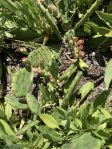
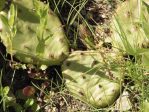

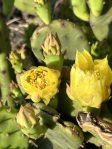
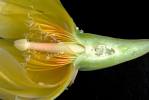
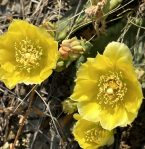



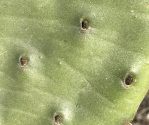



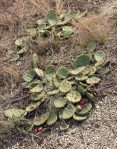
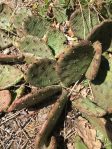
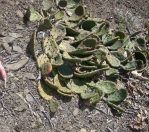
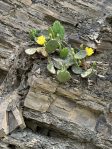

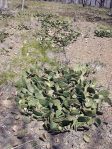
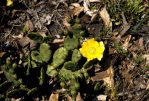

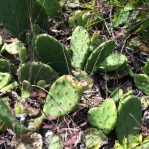




Hi, I am wondering why there are multiple assertions that O. humifusa is spineless, yet many of the pictures you feature show O. humifusa patches/collections that have 1-2 spines per dozen cladodes or so. Nearly spineless? Absolutely. But I wish you would adjust the information given in the article to reflect this.
Hi,
Thanks for your note. It is true, much information suggests O. humifusa has spines. However, in the past few years, Dr. Majure has shown that plants with spines are O. mesacantha or O. cespitosa. These are relatively recent studies and O. mesacantha and O. cespitosa were not even recognized until recently. I have removed any pictures of plants with spines–sorry for any confusion.
See page 40 at: https://opuntiads.com/records/Taxonomic%20revision%20of%20the%20Opuntia%20humifusa%20complex%20in%20eastern%20usa.pdf.
Joe
Hi,
Is the O. humifusa also edible with the same medicinal properties as other varieties?
It seems that under certain conditions, O. humifusa can indeed have spines and extruded glochids. I can vouch for plants from Atsion, NJ (pinelands) and Milford Bluffs (also NJ, cliffs along the Delaware River) being “obvious” straightforward humifusa, but developing spines/extruded glochids when grown in extremely hot/dry conditions. As these characteristics can vary, it brings their usefulness re:identification into question.
Dave,
Thanks for the info.
Joe Shaw